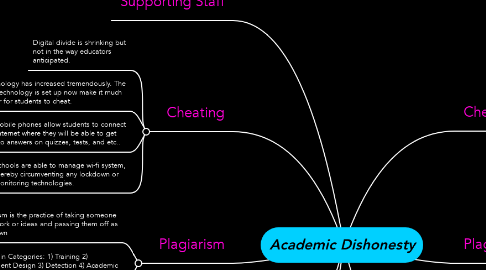Academic Dishonesty
by Vanessa Dease


1. Supporting Staff
2. Cheating
2.1. Digital divide is shrinking but not in the way educators anticipated.
2.2. Technology has increased tremendously. The way technology is set up now make it much easier for students to cheat.
2.3. Most mobile phones allow students to connect to the internet where they will be able to get access to answers on quizzes, tests, and etc..
2.4. Schools are able to manage wi-fi system, thereby circumventing any lockdown or monitoring technologies.
3. Notes
4. Cheating Cont.
4.1. No Child Left behind means that each child will be given the opportunity to pass.
4.2. Specific strategies are set up to make sure each child is learning.
4.3. They fall into three categories: proctoring, test design, and academic culture
4.3.1. Included
4.3.2. Included
4.3.3. Excluded
5. Plagiarism
5.1. Plagiarism is the practice of taking someone else's work or ideas and passing them off as one's own
5.1.1. Project specifications
5.1.2. End User requirements
5.1.3. Action points sign-off
5.2. Four Main Categories: 1) Training 2) Assignment Design 3) Detection 4) Academic Culture
6. Authentication
6.1. Authenticating distance learners is a continuous challenge for online instructors.
6.2. There are strategies that would help improve authentication such as proctor in testing centers, proctor remotely via video, use physical bio-metrics, and etc..
6.3. Proctoring often monitor students during testing
6.4. Identification helps build a student profile. These profiles usually help the computer recognize the user.
7. Plagiarism Cont.
7.1. Teaching how to research is a way you can prevent plagiarism in your classroom.
7.1.1. Materials
7.1.2. Personel
7.1.3. Services
7.1.4. Duration
7.2. Requiring current content help because it limits source materials or references to recent works diminishes the probability of students finding previously submitted assignments to plagiarize.
7.3. Honor pledge is when you require students to make a formal commitment to uphold ethical academic behavior via a signed academic pledge can be an empowering experience
8. Authentication Cont.
8.1. Higher Education Opportunity Act(2008) now requires accrediting agencies to police for systems that verify student identification in online courses.
8.1.1. Dependencies
8.1.2. Milestones
8.2. Many tools came to improve students' identification
8.2.1. Schedule
8.2.2. Budget
8.3. Define Project Development Measurement
8.3.1. KPI's

